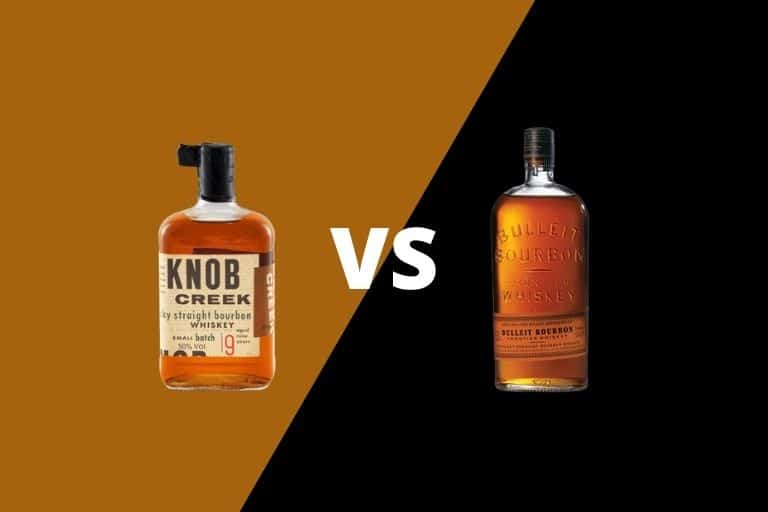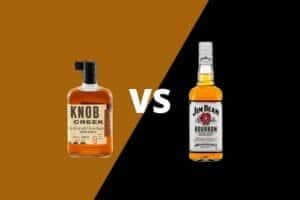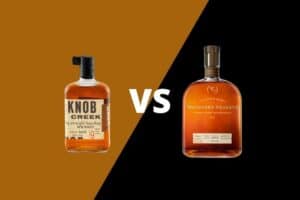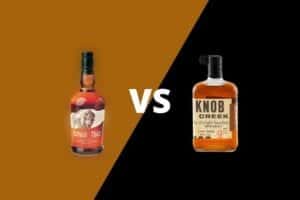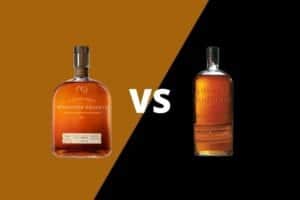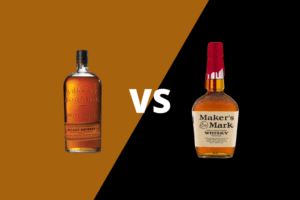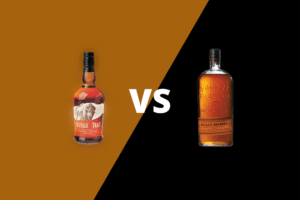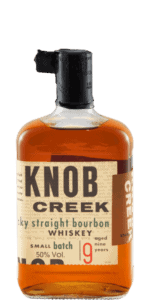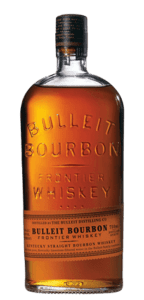Big. Bourbon. Flavor.
Bulleit and Knob Creek bourbons are excellent representations of the American whiskey style — big, bold bourbons with considerable rye content and tons of charred oak flavor.
Bourbon aficionados appreciate these two brands for their complex flavor heavy with delicious barrel notes thanks to time patiently spent maturing in the rickhouse.
If you’re looking for a fantastic bourbon — you’ve come to the right place. If you’re trying to decide between these two knockout brands, grab a glass and read on — we’ll help you make the right choice.
Table of Contents
History
Bourbon fanatics should take note: We might not be where we are today if not for the contributions of these two brands.
Knob Creek was the brainchild of the world-renowned Booker Noe, master distiller for Jim Beam brands for more than 40 years. Among Booker’s many accolades was credit for coining the term ‘small batch,’ which resonates to this day across the wider whiskey world.
Knob Creek was created in 1992. It makes up part of what has become known as Jim Beam’s small batch bourbon collection along with the Booker’s, Baker’s and Basil Haden’s brands. To appreciate their collective impact on the whiskey world, we must consider their introduction in the 1980s and 90s.
At the time, bourbon was a small-margin game — a race to the bottom in price to pick up customers less interested in flavor and more interested in value. Customer preferences had shifted away from whiskey and towards clear, unaged spirits like vodka and gin. Into this landscape, Booker Noe’s small batch collection was launched. It helped change consumer perceptions about bourbon and laid the groundwork for the bourbon renaissance and craft spirits movements that followed.
Bulleit bourbon is also a child of the same turbulent times in whiskey history and was first introduced to the American market in 1987.
Bulleit founder Thomas Bulleit, Jr., named the bourbon after Augustus Bulleit — his great-grandfather, a pioneer and distiller in Kentucky during the 1830s. Thomas Bulleit, Jr., continues to act as an ambassador for the brand.
Ownership
Knob Creek is part of the Jim Beam portfolio purchased by the Japanese-based spirits company Suntory in 2013. The converged Beam Suntory is currently based in Chicago, Illinois. With the addition of the Jim Beam brands to its stable, Beam Suntory is considered the third-largest spirits producer in the world.
Bulleit was purchased by Diageo — the world’s largest spirits producer — in 2001. It is the largest and most well-known bourbon brand in Diageo’s portfolio and represents the cornerstone of the company’s American whiskey strategy worldwide.
Mashbills
Both brands are known for bold flavors. Let’s look at each mash bill — the list of grain ingredients — to find out more about the grains behind each liquid’s taste.
Each brand has the word bourbon on the label, which means they are legally required to contain at least 51 percent corn. But the remaining secondary grains are at the distiller’s discretion.
Knob Creek has a mash bill that includes 75 percent corn, with the remainder nearly evenly split between rye and malted barley — 13 and 12 percent, respectively.
Bulleit’s mash bill contains 68 percent corn, with only 4 percent malted barley. The rest — 28 percent — is rye grain.
These subtle differences in grain ingredients allow the whiskey makers to create drastically different products. In the case of Knob Creek, the extra bit of corn adds more of a sweet corn character to the spirit. By adding more rye grain to the mash bill, the production team at Bulleit ensures more of the rye grain’s spicy, peppery character makes it into the finished product.
Maturation
In the area of maturation, Knob Creek has a significant advantage.
Knob Creek is aged for 9 years. We know this because it is printed in large bold font right on the label — an age statement regulated by the United States Tobacco and Alcohol Tax and Trade Bureau. By printing an age statement of 9 years, Knob Creek is stating that each barrel used in the batch was matured for at least nine years in new American charred oak barrels — with many barrels likely matured for much longer.
Bulleit bourbon does not have an age statement. It is labeled as a Kentucky Straight Bourbon Whiskey. To be labeled a straight bourbon, the spirit must be matured for at least two years in new American charred oak barrels. We know that Bulleit is matured for at least two years, with four or more years being a reasonable estimate of its age.
The maturation process adds the signature vanilla and baking spice flavors that are characteristic of the bourbon category.
Distillation & Production
Let’s check out those distilleries!
Knob Creek has been distilled at the Jim Beam Distillery in Clermont, Kentucky, since its debut in the 1990s.
Bulleit is distilled at the gleaming, new Bulleit Distillery in Shelbyville, Kentucky, which opened in 2017. Since we mentioned most of the barrels going into Bulleit’s standard orange label bourbon expression have been aged for four years or more, the natural question is, ‘Where was it distilled before 2017?’
Bulleit is Diageo’s only major bourbon brand. Before opening the Bulleit Distillery, it did not have distilling capacity in the United States, and Bulleit was offered the product as a Non-Distiller Producer, or NDP.
Price Point & Value
Bulleit has a suggested retail price of about $31 for a 750mL bottle and is offered at 90-proof, or 45 percent alcohol by volume.
You can expect a 750mL bottle of Knob Creek to cost about $35 and it is bottled at 100-proof, or 50 percent ABV.
Tasting Notes
Bulleit Bourbon
Appearance: Bulleit has good legs down the glass at 90-proof. It is reddish-brown/amber in color, with a tawny hue.
Nose: Bold aroma of charred oak, with spicy rye notes, vanilla, honey and caramel.
Palate: Buttery mouthfeel, with vanilla, butterscotch and a hint of maple syrup.
Finish: Vanilla and baking spices, with lingering almond notes.
[Related: Complete Bulleit Bourbon Review]
Knob Creek Bourbon
Appearance: In the glass, Knob Creek appears almost thick enough the chew and, at 100-proof, has beautiful thick legs. Its light brown color hints of auburn and polished mahogany.
Nose: The aroma of rich toffee, with fragrant notes of vanilla, buttery caramel, raisins and honey.
Palate: Heavy barrel oak flavors of baking spices, vanilla and cinnamon, with tobacco and black pepper notes.
Finish: Lingering notes of chocolate, nougat, vanilla, almonds, leather and a pleasant campfire smokiness.
[Related: Complete Knob Creek Bourbon Review]
Verdict…
Leave the entry-level bottles behind. Now we’re in the big leagues!
If you’ve made your way through the standard expression price range and are looking for a reason to drink the premium brands, either bottle listed in this post is a perfect bourbon to enjoy neat or with a few ice cubes. Each of these iconic bourbons has an excellent track record with fans of all stripes — the new bourbon drinker, the professional spirits writer, recent scotch convert and hardcore bourbon enthusiast will each agree their smooth American flavor is a great example of the category.

